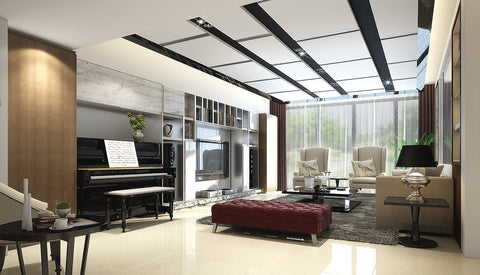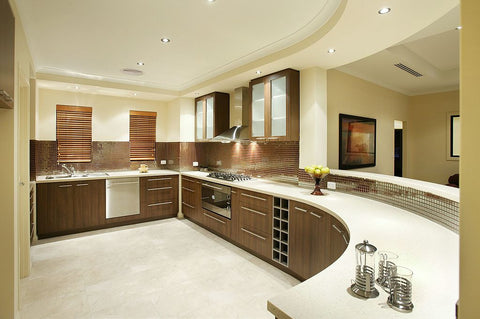9 Lighting Mistakes That Are Holding Your Interior Design Hostage February 22, 2017 00:00

Have you invested an enormous amount of time and effort into your interior design only to have your home still feeling, well, not quite right?
Beautiful furniture, stunning décor, and a spacious layout? Sure, but despite all this, the design still seems just a bit off.
Can’t put your finger on what it is?
Your home might actually be suffering from one of these 9 common lighting mistakes. Have a look at the list below and find out how to bring out your home’s natural beauty with great lighting!
Not taking advantage of natural light
One of the most common mistakes when it comes to home lighting is not taking advantage of natural light.
It’s interior design rule #1 that you should always use natural light when you can and that means relocating bulky furniture and opening those curtains, no matter how great they may look.
Besides the energy cost savings associated with natural light, there are also a host of other benefits to incorporating the sun’s rays into your interior lighting, from improved sleep and productivity to an overall better mood.
Too much/little light for the space
This mistake might seem obvious when you think about it but you’d be astonished at how often it’s still ignored in the real world. When deciding how to light your home, you need to be aware of how much space you are trying to fill.
Recessed lighting, for example, can mean an effective way to light a kitchen but its use in a high-ceiling entryway might make your home appear dark and brooding.
Think of light as an actual resource, with each fixture providing its own, particular amount of light. Instead of the typical “4 light sources per room”, try to look at the lighting needs of a room as a unique puzzle with its own specific lighting solution. What may work in one area simply won’t in another!

Wrong lighting type for the room
Along with determining a room’s specific brightness needs, you’ll also have to be thinking about the “feel” of the room you want to get across. Using row upon row of recessed lighting in the kitchen (another mistake we’ll get to later) is one thing, but doing so in your bedroom is entirely different.
Use soft, ambient light for rooms that you think should have a more welcoming, comfortable atmosphere and some of the more structured lighting choices for more task-oriented spaces.
Light temperature
This tip goes hand in hand with the last one: make sure your lighting temperature matches the mood of the space.
Light temperature has an enormous impact on just what kind of vibe a room gives off. Traditional incandescent bulbs have a softer kind of light, usually referred to as “warm”. Fluorescent and halogen bulbs, on the other hand, tend to give off a “cool” blue light that isn’t quite as welcoming. Knowing the difference between “warm” and “cool” light, and how to use each effectively, can do wonders for your interior design.
Even if your bedroom is only lit by table fixtures and standing lamps, the warmth of the area can be completely negated simply by having a “cool” light source. Luckily, incorporating smart bulbs into your design scheme can entirely bypass this design hiccup as most will let you choose precisely what kind of light the bulb gives off, giving you access to the entire light temperature spectrum, right from your smart device. Technology!

Image by Kanakiakanjurmarg wikinews via Wikimedia
Overdoing recessed lighting
Recessed lighting is a wonderful thing. It’s clean, effective, and is getting cheaper by the day. And while it’s becoming the top lighting fixture used in modern home design today, it’s also becoming more common to go a bit overboard with this particular type of fixture, in kitchens especially.
Relying entirely on recessed lighting to meet your illumination needs can be problematic because these sources are highly directional. A lamp, for instance, tends to disperse light in a variety of directions. Recessed lighting though, will often be more focused, brightening only a small area directly below.
The problem with this type of lighting is it doesn’t shed light on vertical surfaces (e.g. cabinets, refrigerators, walls, etc.) as well. This can lead to a high contrast kitchen with bright counters and dark cabinetry despite a large number of overhead lights. What’s more, direct lighting alone has been shown to have some pretty nasty subconscious side effects as well.
Not enough layering
A great way to combat the high contrast shadows mentioned above is by layering your light. This technique is an effective way to give your rooms not only proper illumination but also complexity and depth that will really bring your décor to life.
There are three types of lighting: ambient, accent, and task. A living room, for example, should include enough ambient light to get around, accent lighting to bring the eye to particularly impressive design elements like sculptures or paintings, and task lighting for reading for instance.

Getting task lighting right
Proper task lighting means really stopping to think about what the space will be used for. Lighting from above, for example, can be great for, say, chopping up vegetables. But when it comes to putting on makeup in the morning, this same kind of light can create shadows on your face in the bathroom mirror.
So, take the time to think about what the light is being used for. It’ll save you from a lot of unnecessary hassle down the line and it’ll add a bit of variety to your design scheme too!
Neglecting the power of dimmers
Dimmers, dimmers, dimmers! What more can we say? Dimmers give you a level of flexibility and control that few other lighting features can offer. They can transform a brightly lit, task-oriented space into a welcoming room you just never want to leave. And all at a moment’s notice!
Smart bulbs make this feature even more accessible as many feature the ability to dim the bulb directly. That means you get to avoid the hassle of installing a dimmer switch and you can even control the bulb right from your phone! Talk about convenience.
Underusing portable fixtures
And last but not least is the underutilization of portable fixtures. As we mentioned earlier, permanent lighting like recessed lights are becoming all the rage and, frankly, that’s unfortunate. Portable fixtures like desk and standing lamps have so much to offer!
Besides the typical warmth and homey feel that these lighting elements bright to a room, they also give you two design elements in one: both light output and fixture design. Let’s see recessed lighting do that!
Let us know what you think!
What other lighting mistakes in home décor have you seen? How has fixing these lighting problems changed the design of your home? Let us know in the comment section below and increase your design flexibility with the Flux Smart product line!
